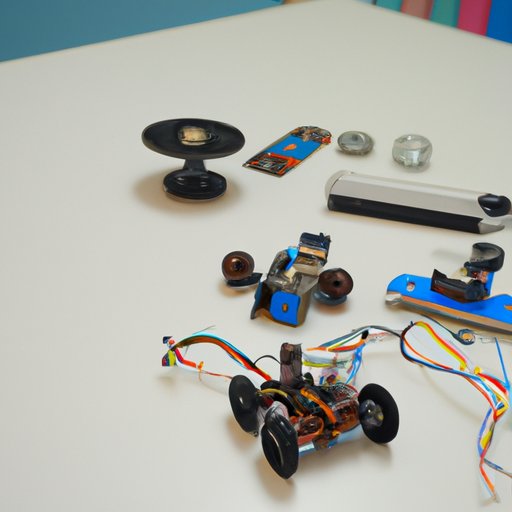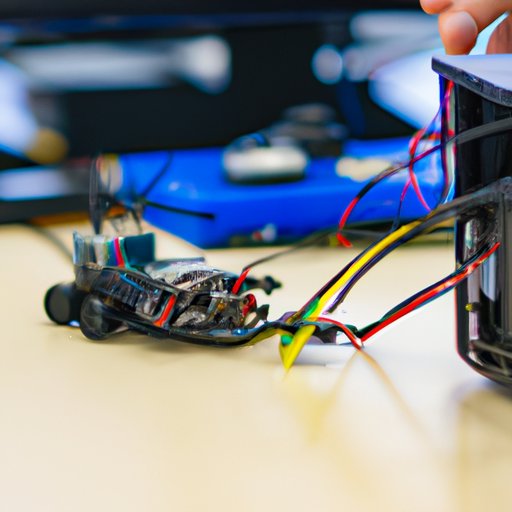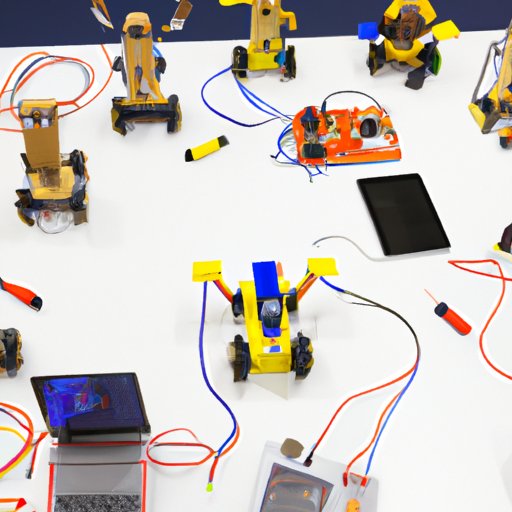Introduction
Robotics is the interdisciplinary study of design, construction, operation, and application of robots. It involves combining different fields such as computer science, engineering, artificial intelligence, and electronics. Robotics has many applications in a variety of industries, from manufacturing to healthcare. As technology advances, robots are becoming increasingly sophisticated and capable of performing complex tasks that were previously only possible by humans.
However, programming robots for these tasks can be quite challenging for beginners. This article provides an in-depth guide to programming robots for beginners, covering the basics of robotics technology and components, building a robot from scratch, programming languages used for robotic applications, fundamentals of robotic control systems, testing and debugging in robotics, and software tools and frameworks available for robotic programming.

Basics of Robotics Technology and Components
Before one can begin programming robots, it is important to understand the basics of robotics technology and components. Robotics is a combination of various technologies such as computer science, engineering, artificial intelligence, and electronics. Each of these technologies has its own set of components and principles that must be understood in order to effectively program robots.
The most basic components of a robot are its sensors, actuators, and controllers. Sensors provide the robot with information about its environment, while actuators are responsible for the robot’s movements. Controllers, on the other hand, are responsible for processing the data received from the sensors and sending commands to the actuators in order to achieve a desired result.
In addition, robots also need to be programmed with specific algorithms and commands in order to function properly. These algorithms and commands will vary depending on the type of robot being programmed. For example, a robotic arm may require different commands than a mobile robot.

Building a Simple Robot from Scratch
Once you understand the basics of robotics technology and components, you can begin building a simple robot from scratch. The first step is to gather all the necessary resources and components. This includes motors, sensors, actuators, and other parts that are needed to construct the robot. You will also need tools such as screwdrivers, pliers, and soldering irons.
Once you have all the necessary components and tools, you can begin assembling the robot. This involves connecting the components together and making sure they are securely fastened. After the robot is assembled, you can then connect the components to the controller and program the robot with the appropriate algorithms and commands.
Programming Languages Used for Robotic Applications
Once the robot is built, it needs to be programmed with the appropriate language. There are several programming languages that can be used for robotic applications, including C++, Python, Java, and other languages. Each language has its own advantages and disadvantages, so it is important to choose the right one for your project.
C++ is a versatile language that is widely used in robotics. It is fast and efficient, and allows for the creation of robust programs. Python is another popular choice for programming robots, as it is relatively easy to learn and use. Java is also a good option for those who want to create more complex programs.
Fundamentals of Robotic Control Systems
In order for a robot to work correctly, it needs to be equipped with the appropriate control system. A control system is responsible for providing the robot with the necessary instructions in order to perform its functions. This includes sensing the environment, processing the data received from sensors, and sending commands to the actuators.
The control system architecture consists of four main components: sensors, actuators, communication protocols, and a controller. Sensors are responsible for providing the robot with information about its environment, while actuators are responsible for the robot’s movements. Communication protocols are responsible for transmitting data between the components, and the controller is responsible for processing the data and sending commands to the actuators.

Testing and Debugging in Robotics
Testing and debugging are critical steps in developing a robotic system. Testing ensures that the robot is functioning as expected, while debugging is responsible for identifying and solving any errors that may be present in the code. It is important to thoroughly test and debug the robot’s code in order to ensure that it is working properly.
Common errors in robotic programming include incorrect sensor readings, unexpected behavior, and faulty actuator commands. In order to identify and solve these errors, it is important to use debugging tools such as breakpoints, print statements, and logging. Once the errors have been identified and solved, the robot should be tested again to ensure that it is functioning as expected.
Software Tools and Frameworks Available for Robotic Programming
There are a number of software tools and frameworks available for robotic programming. The most popular tool is the Robot Operating System (ROS), which is an open-source framework that allows for the development of robotic applications. Other popular tools include OpenCV, a library for computer vision applications, and the Arduino IDE, which is used for programming microcontrollers.
These tools and frameworks provide a range of features that make it easier to develop robotic applications. For example, ROS provides libraries for controlling the robot’s movements, as well as tools for visualizing the robot’s environment. OpenCV provides tools for image processing and object detection, while Arduino IDE allows for the programming of microcontrollers.
Conclusion
Robotics is an exciting field that requires a deep understanding of the underlying technologies and components. This article provided an in-depth guide to programming robots for beginners, covering the basics of robotics technology and components, building a robot from scratch, programming languages used for robotic applications, fundamentals of robotic control systems, testing and debugging in robotics, and software tools and frameworks available for robotic programming.
By understanding the basics of robotics technology and components, building a robot from scratch, and learning the fundamentals of robotic control systems, beginners can begin programming robots with confidence. Additionally, there are a number of software tools and frameworks available that make it easier to develop robotic applications. With the right knowledge and resources, beginners can start their journey into the world of robotics.
(Note: Is this article not meeting your expectations? Do you have knowledge or insights to share? Unlock new opportunities and expand your reach by joining our authors team. Click Registration to join us and share your expertise with our readers.)
